Suborder Myliobatidae Scientific name Manta birostris Rank Species | Phylum Chordata Family Mobulidae Mass 1,600 kg (Adult) Higher classification Manta ray | |
 | ||
Conservation status Vulnerable (Population decreasing) Similar Manta ray, Batoids, Shark, Whale shark, Mobula | ||
Facts the giant oceanic manta ray
The giant oceanic manta ray (Manta birostris) is a species of ray in the family Mobulidae, and the largest type of ray in the world. They are circumglobal and are typically found in tropical and subtropical waters, but can also be found in temperate waters.
Contents
- Facts the giant oceanic manta ray
- Description
- Physical distinctions between oceanic manta ray and reef manta ray
- Distribution habitat
- Biology
- Natural predation
- Fishery
- References
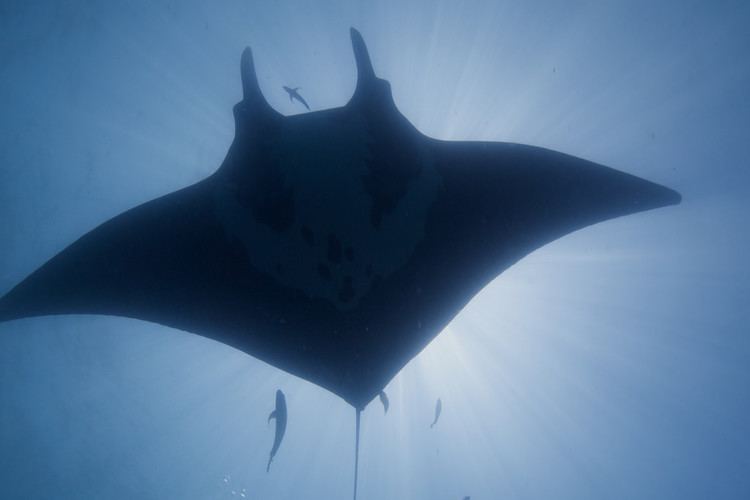
Description
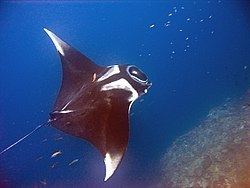
The giant oceanic manta ray can grow to a disc size of up to 7 m (23 ft) with a weight of about 1,350 kg (2,980 lb) but average size commonly observed is 4.5 m (15 ft). It is dorsoventrally flattened and has large, triangular pectoral fins on either side of the disc. At the front, it has a pair of cephalic fins which are forward extensions of the pectoral fins. These can be rolled up in a spiral for swimming or can be flared out to channel water into the large, forward-pointing, rectangular mouth when the animal is feeding. The teeth are in a band of 18 rows and are restricted to the central part of the lower jaw. The eyes and the spiracles are on the side of the head behind the cephalic fins, and the gill slits are on the ventral (under) surface. It has a small dorsal fin and the tail is long and whip-like. The manta ray does not have a spiny tail as do the closely related devil rays (Mobula spp.) but has a knob-like bulge at base of its tail. The skin is smooth with a scattering of conical and ridge-shaped tubercles. The colouring of the dorsal (upper) surface is black, dark brown, or steely blue, sometimes with a few pale spots and usually with a pale edge. The ventral surface is white, sometimes with dark spots and blotches. The markings can often be used to recognise individual fish. Manta birostris is similar in appearance to Manta alfredi and the two species may be confused as their distribution overlaps. However, there are distinguishing features.
Physical distinctions between oceanic manta ray and reef manta ray
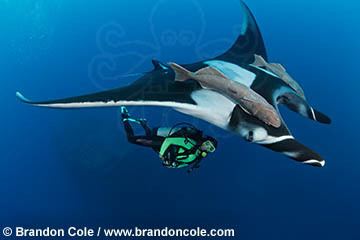
The first difference could be the size because the oceanic manta ray is bigger than the reef manta ray, 4 to 5 meters in average against 3 to 3.5 meters. However, if the observed rays are young, their size can easily bring confusion. Only the color pattern remains an effective way to distinguish them. The reef manta ray has a dark dorsal side with usually two lighter areas on top of the head, looking like a nuanced gradient of its dark dominating back coloration and whitish to greyish, the longitudinal separation between these two lighter areas forms a kind of "Y". While for the oceanic manta ray, the dorsal surface is deep dark and the two white areas are well marked without gradient effect. The line of separation between these two white areas form meanwhile a "T".
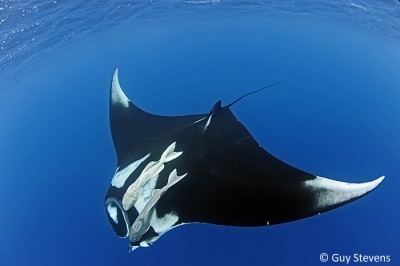
Difference can also been made by their ventral coloration, the reef manta ray has a white belly with often spots between the branchial gill slits and other spots spread across trailing edge of pectoral fins and abdominal region. The oceanic manta ray has also a white ventral coloration with spots clustered around lower region of its abdomen. Its cephalic fins, inside of its mouth and its gill slits are often black.
Distribution & habitat

The giant oceanic manta ray has a widespread distribution in tropical and temperate waters worldwide. In the Northern Hemisphere, it has been recorded as far north as southern California and New Jersey in the United States, Aomori Prefecture in Japan, the Sinai Peninsula in Egypt, and the Azores in the northern Atlantic. In the Southern Hemisphere, it occurs as far south as Peru, Uruguay, South Africa, and New Zealand.
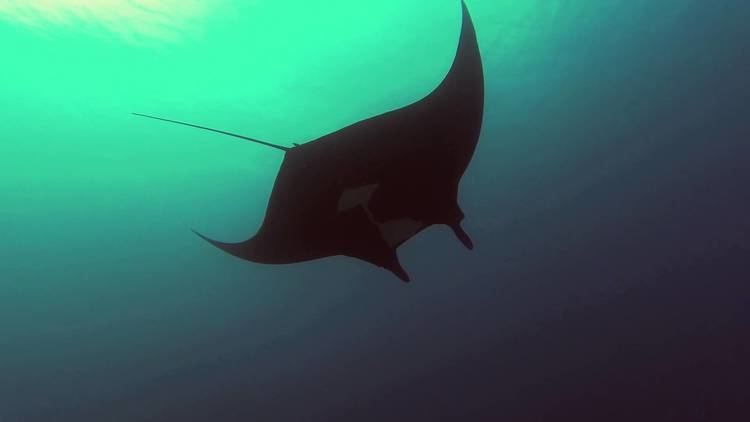
It is an ocean-going species and spends most of its life far from land, travelling with the currents and migrating to areas where upwellings of nutrient-rich water increase the availability of zooplankton. The oceanic manta ray is often in association with offshore oceanic islands.
Biology
When traveling in deep water, the giant oceanic manta ray swims steadily in a straight line, while further inshore it usually basks or swims idly around. Mantas may travel alone or in groups of up to 50 and sometimes associate with other fish species, as well as sea birds and marine mammals. They are filter feeders and consume large quantities of zooplankton in the form of shrimp, krill, and planktonic crabs. An individual manta may eat about 13% of its body weight each week. When foraging, it usually swims slowly around its prey, herding the planktonic creatures into a tight group before speeding through the bunched-up organisms with its mouth open wide. While feeding, the cephalic fins are spread to channel the prey into its mouth and the small particles are sifted from the water by the tissue between the gill arches. As many as 50 individual fish may gather at a single, plankton-rich feeding site.
The giant oceanic manta ray sometimes visits a cleaning station on a coral reef, where it adopts a near-stationary position for several minutes while cleaner fish consume bits of loose skin and external parasites. Such visits occur most frequently at high tide. It does not rest on the seabed as do many flat fish, as it needs to swim continuously to channel water over its gills for respiration.
Males become sexually mature when their disc width is about 4 m (13 ft), while females need to be about 5 m (16 ft) wide to breed. When a female is becoming receptive, one or several males may swim along behind her in a "train". During copulation, one of these males grips the female's pectoral fin with his teeth and they continue to swim with their ventral surfaces in contact. He inserts his claspers into her cloaca and these form a tube through which the sperm is pumped. The pair remains coupled together for several minutes before going their own ways.
The fertilized eggs develop within the female's oviduct. At first, they are enclosed in an egg case and the developing embryos feeds on the yolk. After the egg hatches, the pup remains in the oviduct and receives nourishment from a milky secretion. As it does not have a placental connection with its mother, the pup relies on buccal pumping to obtain oxygen. The brood size is usually one but occasionally two embryos develop simultaneously. The gestation period is thought to be 12–13 months. When fully developed, the pup is 1.4 m (4 ft 7 in) in disc width, weighs 9 kg (20 lb) and resembles an adult. It is expelled from the oviduct, usually near the coast, and it remains in a shallow-water environment for a few years while it grows.
Natural predation
Because of its large size and velocity in case of danger (24 km/h escape speed), the oceanic manta ray has very few natural predators that could be fatal to it. Only large sharks and dolphins, such as the tiger shark (Galeocerdo cuvier), the great hammerhead shark (Sphyrna mokarran), the bullshark (Carcharhinus leucas), the False killer whale (Pseudora crassidens), and the killer whale (Orcinus orca), are capable of preying on the ray. Nonlethal shark bites are very common occurrences, with a vast majority of adult individuals bearing the scars of at least one attack.
Fishery
The oceanic manta ray is considered to be vulnerable by the IUCN’s Red List of Endangered Species because its population has decreased drastically over the last twenty years due to overfishing. Whatever the type of fishing (artisanal, targeted or bycatch), the impact on a population which has a low fecundity rate, a long gestation period with mainly a single pup at a time, and a late sexual maturity can only be seriously detrimental to a species that cannot compensate for the losses over several decades. In recent years, fishing for manta rays has been significantly boosted by the price of their gill rakers on the traditional Chinese Medicine market, where fabricated medicinal virtues have been assigned to them without proven scientific basis and a clever marketing strategy has generated significant demand.
